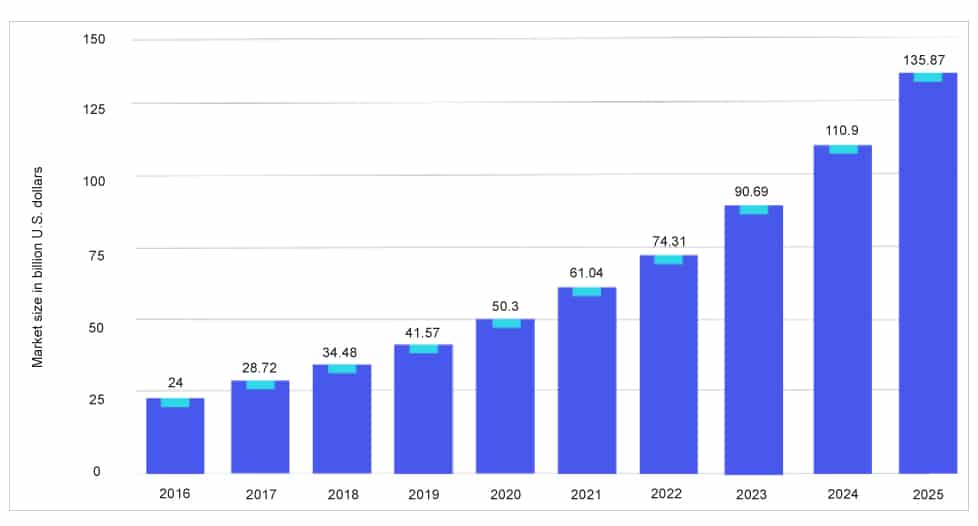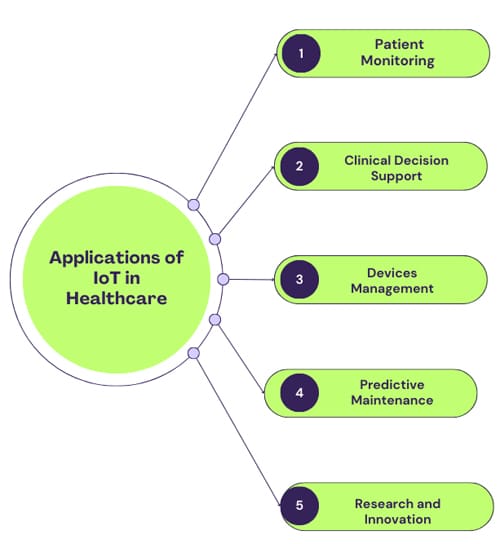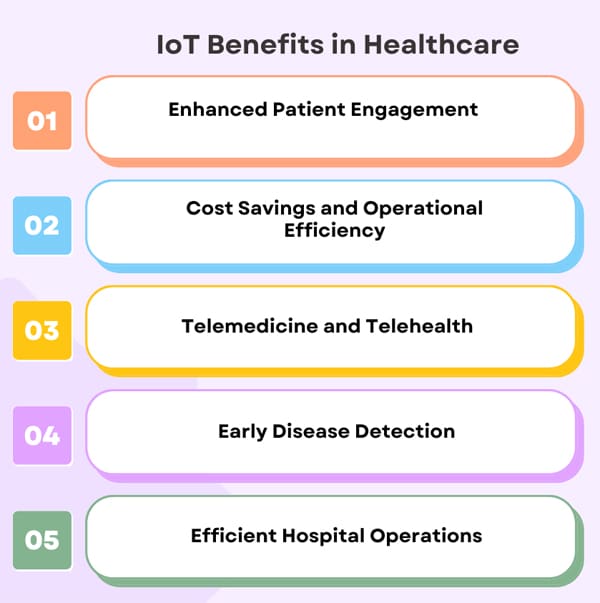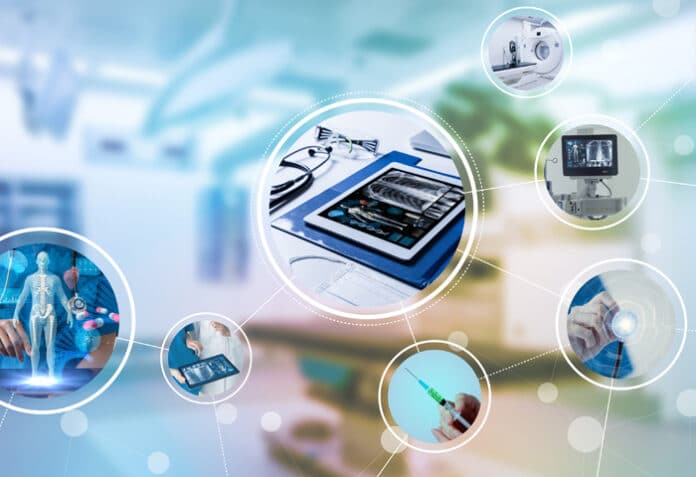Healthcare is being transformed by the Internet of Things (IoT), and becoming more effective, data-driven, and patient-centred. We take a look at the transformative impact of IoT on the healthcare industry, outlining its potential to improve patient treatment and increase overall healthcare.
The healthcare sector has seen a significant surge in the adoption of Internet of Things (IoT) devices during 2023. Based on a report published by MarketsandMarkets, the worldwide market for IoT in the healthcare sector is anticipated to reach $188 billion by 2025. This growth is expected to be achieved through a compound yearly growth rate (CAGR) of 29.9% from 2020 to 2025.
Figure 1 shows IoT’s growth trajectory in the healthcare business.

Key applications of IoT in healthcare
IoT has diverse applications in healthcare, driving improvements in patient care, clinical processes, and operational efficiency (Figure 2).

Patient monitoring: Through the Internet of Things, doctors can remotely monitor their patients’ vital signs, the progress of long-term illnesses, and post-surgery recovery. They can identify potential issues early, and deliver timely interventions, reducing the likelihood of hospital readmissions.
Clinical decision support: IoT applications provide real-time patient data, empowering healthcare professionals to make well-informed decisions, thus improving patient care and reducing the occurrence of medical errors.
Device management: IoT is used to manage the status of medical equipment within healthcare facilities. This minimises equipment loss, optimises asset utilisation, and ensures the availability of critical resources.
Predictive maintenance: IoT aids in predicting when medical devices require maintenance or replacement, thereby reducing downtime and ensuring the continuous availability of equipment for patient care.
Research and innovation: IoT-enabled devices and wearables are employed in clinical trials to collect participant data, significantly improving the efficiency and accuracy of medical research, and aiding in drug development.
IoT benefits in healthcare
There are various benefits of integrating IoT in healthcare (Figure 3).

Enhanced patient engagement: With the support of the Internet of Things (IoT), medical portals and mobile apps can actively involve patients in their treatment. Consequently, patients are more likely to participate in their care and report higher satisfaction with their healthcare professionals.
Cost savings and operational efficiency: IoT and telehealth have demonstrated their cost-effectiveness for both patients and healthcare systems. A report by Deloitte estimates that IoT in healthcare has the potential to annually save the industry up to $300 billion through remote patient monitoring, preventive care, and improved medication adherence.
Telemedicine and telehealth services: Telemedicine and IoT infrastructure extend healthcare accessibility to remote or underdeveloped areas. Telehealth services also reduce the necessity for in-person visits, improving overall access to healthcare.
Early disease detection: IoT devices continuously monitor and analyse patient data in real time, enabling the early detection of signs of diseases or health deterioration. This leads to timely interventions and improved health outcomes.
Efficient hospital operations: IoT optimises hospital operations by tracking equipment, managing inventory, and monitoring environmental conditions. This optimisation leads to cost savings, improved efficiency, and enhanced patient safety.
Open source simulation tools for IoT implementation
Several open source simulation tools can be used for implementing and testing IoT applications. These tools offer flexibility and customisation, making them suitable for many IoT projects. Table 1 gives a comparison of popular IoT simulation tools.
Table 1: A comparison of IoT simulation tools
| Features | COOJA | NS-3 | OMNeT++ | NetSim |
| Simulation purpose | Wireless sensor networks | Network and IoT | Network and IoT | Network and IoT |
| Licence | BSD | Open source | Academic public licence | Open source |
| Simulation language | Java | C++ and Python | C, C++ | Java, HTML and XML |
| Mobility support | Yes | Yes | Yes | Yes |
| Customisation | Limited | Extensible | Highly extensible | Extensible |
| Network protocols | IEEE 802.15.4, 6LoWPAN | Various IoT protocols | Various IoT protocols | Various IoT protocols |
| Operating systems | Cross-platform | Cross-platform | Cross-platform | Windows-based |
| Ease of use |
Beginner-friendly | Requires coding skills | Requires coding skills | Beginner-friendly with scripting |
| Real-time simulation | Limited | Supported | Supported | Limited support |
| Application areas | WSN and IoT research | A broad range of IoT apps | IoT and communication | IoT research and development |
Python libraries for IoT-enabled healthcare implementation
Python is a versatile programming language with many libraries that can be used in IoT-enabled healthcare implementations. Table 2 lists popular Python libraries that are commonly used in IoT-enabled healthcare projects.
Table 2: Popular Python libraries for IoT-enabled healthcare projects
| Library | Description | Features | Use cases | Version |
| OpenCV | Computer vision and image processing | Image, video processing, object detection, image recognition | Medical imaging, diagnostic analysis, patient monitoring | OpenCV 4.8.0 |
| PyHealth | Machine learning library for healthcare | Simplifies data preprocessing and model deployment | Predictive analytics, patient risk stratification, readmission prediction | PyHealth 1.1.4 |
| MNE-Python | Data analysis for electrophysiology and neuroimaging | Analysis of EEG, MEG, and other neural data, machine learning tools for data interpretation | Neuroimaging research, epilepsy monitoring, brain-computer interfaces | mne 1.5. 1 |
| BlueZ | Bluetooth stack for IoT and healthcare devices | Supports IoT devices’ Bluetooth connectivity | Wearable health monitors, Bluetooth-enabled medical devices | BlueZ 5.63 |
| PyDICOM | DICOM file manipulation for medical imaging | Read and write DICOM files – helps extract and manipulate metadata from medical images | Medical image management, radiology, picture archiving, and communication systems (PACS) | PyDICOM 1.1.0 |
| scikit-learn | Machine learning for healthcare data analysis | Supports classification, regression, clustering | Predictive modelling, disease prediction, patient risk assessment | scikit-learn 1.3.1 |
IoT is not just changing how we think about healthcare — it’s changing how we experience it. Patients are more engaged, doctors better informed, and hospitals vastly more efficient. The Internet of Things is the connective thread, creating a more inter-connected, efficient, and compassionate healthcare system.




